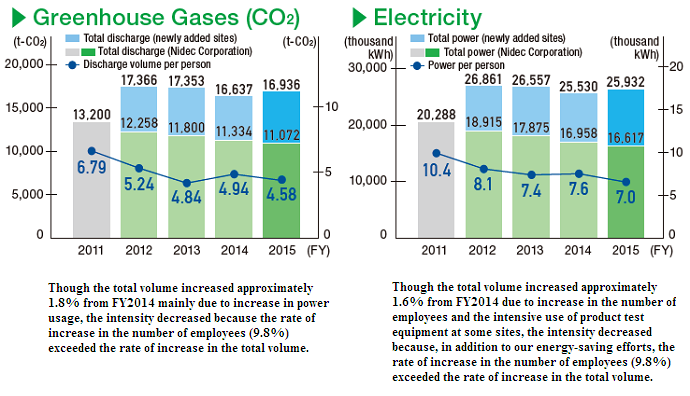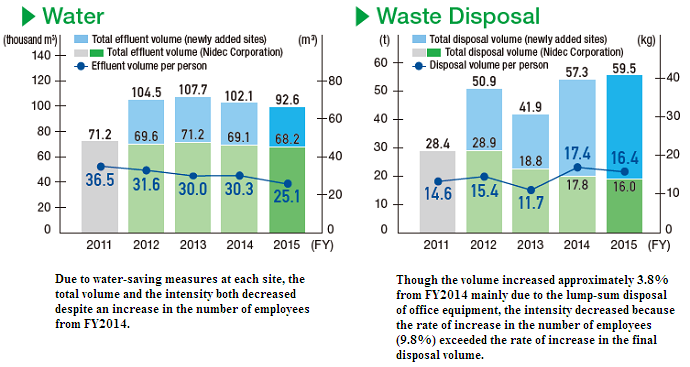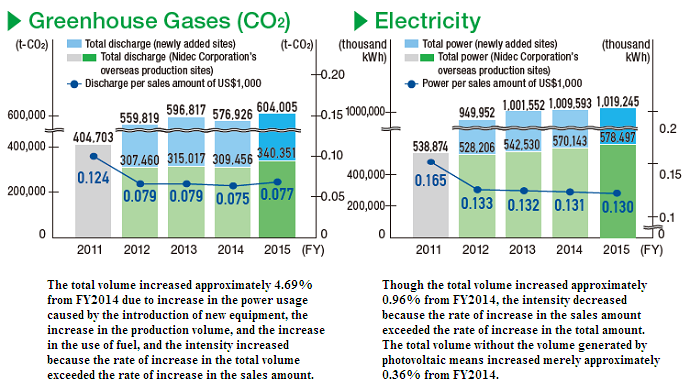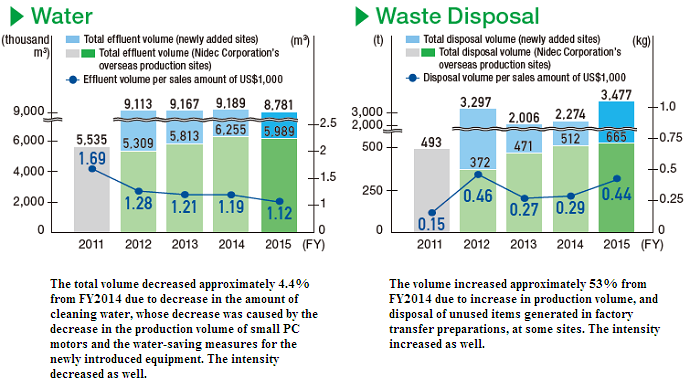Environmental Performance
Environmental Performance 2015
Overview of Nidec’s Environmental Burden
A majority of the greenhouse gases emitted as a result of Nidec’s business activities is derived from electricity and fuel consumption. Improving the way we use energy at production sites is a crucial factor in reducing greenhouse gas emissions.

Overview of the Fourth Medium-term Environmental Conservation Plan
Nidec first formulated a medium-term environmental conservation plan in FY2004, and it has been renewing it every three years. The fourth medium-term plan, launched in FY2013, ended in FY2015.For the four areas of reducing environmental impact (out of the total of seven areas covered by the plan), business sites were categorized into non-production and production-sites. The goal was to reduce the three-year average by 3% on an intensity basis* from base year FY2012 levels.
*Intensity basis: Per employee for non-production sites, and per US$1,000 for production sites.
| Activity | Fourth Mid-Term Plan (FY2013–FY2015) | ||
|---|---|---|---|
|
Three-year targets |
FY2015 results |
FY2013 - FY2015 results |
|
|
Reduction of greenhouse gas(CO2) emissions |
For both non-production and production sites, reduce greenhouse gas emissions by an average of 3% over a three-year period on a basic unit basis, compared to FY2012 levels. | ■Non-production sites: Down 12.6% from the base year
FY2012 levels on an intensity basis. ■Production sites: Down 1.6% from the base year FY2012 levels on an intensity basis. |
■Non-production sites: Down 8.7% from the base year
FY2012 levels on an intensity basis. ■Production sites: Down 2.0% from the base year FY2012 levels on an intensity basis. |
| Power usage reduction | For both non-production and production sites, reduce power usage by an average of 3% over a three-year period on a basic unit basis, compared to FY2012 levels. | ■Non-production sites: Down 13.7% from the base year
FY2012 levels on an intensity basis. ■Production sites: Down 2.1% from the base year FY2012 levels on an intensity basis. |
■Non-production sites: Down 9.8% from the base year
FY2012 levels on an intensity basis. ■Production sites: Down 1.6% from the base year FY2012 levels on an intensity basis. |
| Water usage reduction | For both non-production and production sites, reduce water usage by an average of 3% over a three-year period on a basic unit basis, compared to FY2012 levels. | ■Non-production sites: Down 20.8% from the base year
FY2012 levels on an intensity basis. ■Production sites: Down 12.1% from the base year FY2012 levels on an intensity basis. |
■Non-production sites: Down 10.0% from the base year
FY2012 levels on an intensity basis. ■Production sites: Down 8.1% from the base year FY2012 levels on an intensity basis. |
| Reduction of final waste disposal volume | For both non-production and production sites, reduce final waste disposal volume by an average of 3% over a three-year period on a basic unit basis, compared to FY2012 levels. | ■Non-production sites: Up 6.8% from the base year
FY2012 levels on an intensity basis. ■Production sites: Down 3.8% from the base year FY2012 levels on an intensity basis. |
■Non-production sites: Down 1.3% from the base year
FY2012 levels on an intensity basis. ■Production sites: Down 27.6% from the base year FY2012 levels on an intensity basis. |
| Environmental management |
Based on the ISO audit, establish a comprehensive product quality and environmental assessment system for domestic and overseas sites. |
■The quality and environmental management levels of Nidec sites in Japan improved after the acquisition/renewal of the ISO14001 and ISO9001 certifications. In addition, the sites' certification authorities were unified upon the acquisition/renewal (action ongoing). |
■The quality and environmental management levels of Nidec sites in Japan improved after the acquisition/renewal of the ISO14001 and ISO9001 certifications. In addition, the sites' certification authorities were unified upon the acquisition/renewal (action ongoing). ■To introduce an environmental management system to those sites yet to obtain the ISO14001 certification, we conducted onsite inspections based on EICC-based environmental aspects. |
| Product-based environmental contribution | Promote the development and widespread use of products that will contribute to conservation of the global environment. | ■Supply of high-efficiency, energy-saving industrial,
appliance, and other motors ■Supply of renewable energy systems (photovoltaic and wind power generators). |
■Nidec developed and produced EV, HEV, and other automotive motors (including motors for electric power steering systems), inverter air conditioner motors, rare earth-free (SR) motors, high-efficiency motors that meet the IE3 (premium efficiency) regulations, and photovoltaic plants among other products. |
| Environmental communication | In association with external organizations, promote volunteer activities for biodiversity conservation. | ■Participation in forest improvement, tree plantation,
and other volunteer activities that contribute to
biodiversity conservation. In Thailand, 280 Nidec employees planted a total of 1,000 mangrove trees in FY2015. |
■Nidec employees participated in forest maintenance, tree plantation, and other volunteer activities to help maintain biodiversity. |
| Contribute to environmental education in local communities. | ■We held the eco class for elementary students nine times in Japan. *For more information on environmental communication activities and other related news, click here. |
■We held the eco class for elementary students 22 times in Japan and four times overseas. | |







Summary of the Fourth Medium-term Environmental Conservation Plan
The result of the fourth medium-term environmental conservation plan is as follows. Individual sites’ FY2013–FY2015 environmental burden figures were averaged out on an intensity basis and compared to the result of the base year FY2012.

While the overall amount of environmental burden on an intensity basis reduced, Nidec failed to achieve its target reduction amount (reduce the three-year average by 3% on an intensity basis from base year FY2012 levels) in three areas: final waste disposal for non-production sites and greenhouse gases and electricity for production sites. Targets were missed due to the mass-disposal of office supplies, the introduction of manufacturing equipment upon the start of new business, and an expansion in production, respectively.
Overview of the Fifth Medium-term Environmental Conservation Plan
The fifth medium-term environmental conservation plan
(FY2016–FY2018) was launched in FY2016. While the fourth
medium-term environmental conservation plan covered Nidec
Corporation, its overseas production sites, and Nidec Group
subsidiaries that joined the Nidec Group via M&A and that are
headquartered in Japan, the fifth medium-term environmental
conservation plan will expand coverage by adding Nidec Group
subsidiaries headquartered overseas.
The fifth medium-term environmental conservation plan will also
see our Group’s continued efforts to reduce greenhouse gas
generated from our business activities. We will also quantify the
effect from greenhouse gas reductions resulting from the use of
Nidec Group products as the “amount of environmental
contribution.”
Thus, we will be able to visualize correlations between the amount
of our environmental contribution and our sales and profit, and to
integrate the Group’s business growth and environmental objectives.
Our final goal is to see the total amount of environmental contribution
from the use of Nidec Group products exceed the total amount of
environmental burden generated from our business activities.


